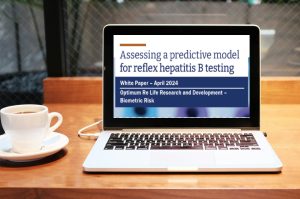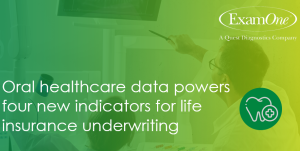As we wrap up Life Insurance Awareness Month, John Reynolds, Senior Vice President of Health Data Insights division for ExamOne, shares his thoughts on how and why the life insurance industry is experiencing rapid adoption of instantaneous health data in the underwriting process. Find out why John believes faster data will help move the life insurance industry forward now and in the future.
Consumers expect faster application completions
COVID-19 not only increased consumers’ demand for life insurance coverage but also the “instant gratification” mentality stemming from on-demand responses from retail and grocery delivery vendors. Accelerated underwriting has been around for years, but implementation was slow. Now, due to pandemic-fueled consumer demand, it’s here to stay. In the interest of growing application volume and improving the overall applicant experience, the life insurance industry wants real-time, health-based data and behavioral data. These data solutions help facilitate life insurance coverage without the long delays of traditional requirements.
I believe the pandemic sped up the industry adoption of health data utilization, which would have probably taken 5-7 years previously. Almost instantly, some applicants preferred contactless interactions for safety concerns. We also saw firsthand a very quick pivot from insurers slowly investigating new data tools to quickly turning them on. The faster process can be advantageous for both consumers and insurers, while still ensuring effective and confident risk assessment.
Historical health data provide powerful medical condition insight
Insurance paramedical exams and fluid specimens have traditionally been used to reveal important evidence for risk assessment of life insurance applications. Last year, nearly all reinsurers dedicated a significant amount of time and resources studying the value and adoption opportunities in historical clinical laboratory data, like LabPiQture™. GenRe published a white paper evaluating the use of historical clinical laboratory data when accelerated or fluid-less underwriting is utilized. Their study concluded that historical laboratory data “can replace some of the evidence lost by the elimination of fluid tests.” Other reinsurers also published their findings on historical laboratory data and all reported that these types of data are critical information to insurers
In the past, if an insurer needed to confirm that an applicant has diabetes, the insurer would pull an old-fashioned APS, which is painfully slow and expensive. Real-time health data is a faster, more cost-effective solution. Traditional underwriting with a paramedical exam and health data still offers the most comprehensive access to an applicant’s health. However, a benefit of real-time health data is that it fits perfectly into an accelerated underwriting program or supplements the traditional, full underwriting requirements.
Carriers and underwriters want tools to be more effective
The effectiveness and value of health data tools for life insurers continues to be proven more every day. Now, the priority in the industry is to develop tools to improve workflow processes. Then carriers can easily interpret and utilize these data at their fingertips. The days of asking an underwriter to scan through long PDFs and paper reports are coming to an end.
I have spoken on many client and partner webinars over the past several months, including LIDMA’s “Data Trends: Accelerating the Approval Process.” A recurring theme has been how to develop best practices around incorporating these data into workflows and engines. The depth and breadth of the available data pose challenges in utilizing the information at scale. It is similar to 20 years ago when the industry began incorporating prescription history data in the underwriting process. Codes and categorization offer an opportunity to standardize scoring and risk classification. Reinsurers and underwriting departments have begun the process of writing rules and introducing new tools for automated systems, the most recent example of HannoverRe’s reFlex tool.
Currently, there isn’t one right answer to “how” to use these data. The “how” is evolving as quickly as the “why” did at the peak of the pandemic. However, the speed of health data utilization is a testament to innovation and resilience in our industry. Consumers and insurers alike are benefitting from a pivot that none of us could imagine. The future of health data for life insurance is now.
Here to help incorporate health data solutions into your workflow
ExamOne is here to help clients determine the best ways to incorporate data solutions into their workflow. As the industry innovates quickly, our data insights team and Senior Underwriter Heather Haslam are helping to navigate these new paths. Follow John on LinkedIn for other industry updates or visit ExamOne.com to find out more about ExamOne’s health data solutions.




















As we wrap up Life Insurance Awareness Month, John Reynolds, Senior Vice President of Health Data Insights division for ExamOne, shares his thoughts on how and why the life insurance industry is experiencing rapid adoption of instantaneous health data in the underwriting process. Find out why John believes faster data will help move the life insurance industry forward now and in the future.
Consumers expect faster application completions
COVID-19 not only increased consumers’ demand for life insurance coverage but also the “instant gratification” mentality stemming from on-demand responses from retail and grocery delivery vendors. Accelerated underwriting has been around for years, but implementation was slow. Now, due to pandemic-fueled consumer demand, it’s here to stay. In the interest of growing application volume and improving the overall applicant experience, the life insurance industry wants real-time, health-based data and behavioral data. These data solutions help facilitate life insurance coverage without the long delays of traditional requirements.
I believe the pandemic sped up the industry adoption of health data utilization, which would have probably taken 5-7 years previously. Almost instantly, some applicants preferred contactless interactions for safety concerns. We also saw firsthand a very quick pivot from insurers slowly investigating new data tools to quickly turning them on. The faster process can be advantageous for both consumers and insurers, while still ensuring effective and confident risk assessment.
Historical health data provide powerful medical condition insight
Insurance paramedical exams and fluid specimens have traditionally been used to reveal important evidence for risk assessment of life insurance applications. Last year, nearly all reinsurers dedicated a significant amount of time and resources studying the value and adoption opportunities in historical clinical laboratory data, like LabPiQture™. GenRe published a white paper evaluating the use of historical clinical laboratory data when accelerated or fluid-less underwriting is utilized. Their study concluded that historical laboratory data “can replace some of the evidence lost by the elimination of fluid tests.” Other reinsurers also published their findings on historical laboratory data and all reported that these types of data are critical information to insurers
In the past, if an insurer needed to confirm that an applicant has diabetes, the insurer would pull an old-fashioned APS, which is painfully slow and expensive. Real-time health data is a faster, more cost-effective solution. Traditional underwriting with a paramedical exam and health data still offers the most comprehensive access to an applicant’s health. However, a benefit of real-time health data is that it fits perfectly into an accelerated underwriting program or supplements the traditional, full underwriting requirements.
Carriers and underwriters want tools to be more effective
The effectiveness and value of health data tools for life insurers continues to be proven more every day. Now, the priority in the industry is to develop tools to improve workflow processes. Then carriers can easily interpret and utilize these data at their fingertips. The days of asking an underwriter to scan through long PDFs and paper reports are coming to an end.
I have spoken on many client and partner webinars over the past several months, including LIDMA’s “Data Trends: Accelerating the Approval Process.” A recurring theme has been how to develop best practices around incorporating these data into workflows and engines. The depth and breadth of the available data pose challenges in utilizing the information at scale. It is similar to 20 years ago when the industry began incorporating prescription history data in the underwriting process. Codes and categorization offer an opportunity to standardize scoring and risk classification. Reinsurers and underwriting departments have begun the process of writing rules and introducing new tools for automated systems, the most recent example of HannoverRe’s reFlex tool.
Currently, there isn’t one right answer to “how” to use these data. The “how” is evolving as quickly as the “why” did at the peak of the pandemic. However, the speed of health data utilization is a testament to innovation and resilience in our industry. Consumers and insurers alike are benefitting from a pivot that none of us could imagine. The future of health data for life insurance is now.
Here to help incorporate health data solutions into your workflow
ExamOne is here to help clients determine the best ways to incorporate data solutions into their workflow. As the industry innovates quickly, our data insights team and Senior Underwriter Heather Haslam are helping to navigate these new paths. Follow John on LinkedIn for other industry updates or visit ExamOne.com to find out more about ExamOne’s health data solutions.